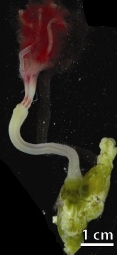
Siboglinidae is a family of polychaete annelid worms whose members made up the former phyla Pogonophora and Vestimentifera. They are composed of about 100 species of vermiform creatures and live in thin tubes buried in sediments (Pogonophora) or in tubes attached to hard substratum (Vestimentifera) at ocean depths from 100 to 10,000 m. They can also be found in association with hydrothermal vents, methane seeps, sunken plant material, or whale carcasses.
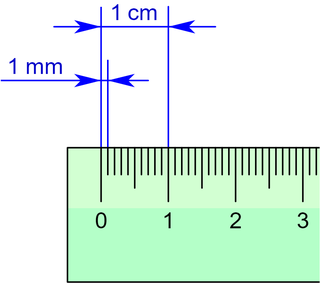
The millimetre or millimeter is a unit of length in the metric system, equal to one thousandth of a metre, which is the SI base unit of length. Therefore, there are one thousand millimetres in a metre. There are ten millimetres in a centimetre.
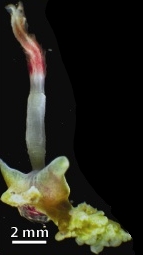
Osedax is a genus of deep-sea siboglinid polychaetes, commonly called boneworms, zombie worms, or bone-eating worms. Osedax is Latin for "bone-eater". The name alludes to how the worms bore into the bones of whale carcasses to reach enclosed lipids, on which they rely for sustenance. They utilize specialized root tissues for bone-boring. It is possible that multiple species of Osedax reside in the same bone. Osedax worms are also known to feed on the collagen itself by making holes in the whale's skeletal structure. These holes can also serve as a form of protection from nearby predators.

Xenoturbella is a genus of very simple bilaterians up to a few centimeters long. It contains a small number of marine benthic worm-like species.

The Monterey Bay Aquarium Research Institute (MBARI) is a private, non-profit oceanographic research center in Moss Landing, California. MBARI was founded in 1987 by David Packard, and is primarily funded by the David and Lucile Packard Foundation. Christopher Scholin serves as the institute's president and chief executive officer, managing a work force of approximately 220 scientists, engineers, and operations and administrative staff.

The smallest organisms found on Earth can be determined according to various aspects of organism size, including volume, mass, height, length, or genome size.

A trophosome is a highly vascularised organ found in some animals that houses symbiotic bacteria that provide food for their host. Trophosomes are located in the coelomic cavity in the vestimentiferan tube worms and in symbiotic flatworms of the genus Paracatenula.

Osedax roseus is a species of bathypelagic polychaete worm that lives at abyssal depths and is able to sustain itself on the bones of dead whales. The species is found in the North East Pacific.
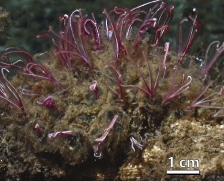
Osedax frankpressi is a species of bathypelagic polychaete worm that lives on the seabed and sustains itself on the bones of dead whales. It can be found in the East North Pacific Ocean. The specific epithet is named in honor of Frank Press "for his distinguished service to science".
Luzula nivalis, commonly known as arctic wood-rush or less commonly as snowy wood-rush, is a species of perennial rush native to the North American Arctic and Northern Europe. It was described by Polunin (1940) as one of the most abundant, ubiquitous, and ecologically important of all arctic plants.

Oplismenus undulatifolius, commonly known as wavyleaf basketgrass, is a species of perennial grass from the family Poaceae that is native to Eurasia, specifically Southern Europe through Southern Asia. Due to its invasive nature, it can be found in countries such as Pakistan, China, Japan, Korea, India, Australia, South Africa, and has since been introduced to the Mid-Atlantic United States. There are no recognized subspecies in Catalogue of Life.
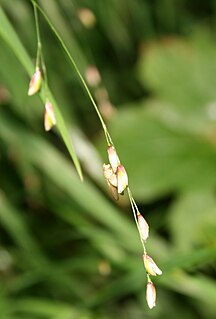
Melica uniflora, commonly known as wood melick, is a species of grass in the family Poaceae that is native to much of Europe, and to parts of South West Asia and North Africa.
Melica yajiangensis, is a species of grass that is endemic to China.

Melica transsilvanica is a species of grass found in Europe and temperate Asia, including Caucasus and China.
Melica scaberrima, is a species of grass that can be found in Yunnan, China, Nepal, Pakistan and northern part of India.
Chaco tucumana is a species of mygalomorph spiders of Argentina, named after its type locality: Tucumán. This species differs from C. obscura in the shorter male embolus and the shorter female spermathecal ducts. From other species of the genus it differs in its dark uniform color, the flexible anterior female tarsi, the denser scopulae on the posterior tarsi, and the female spermathecae without a basal protuberance. As in C. obscura, smaller specimens are much lighter in color, and it has darker spots that are evident on the sides of its cephalic region, the apex of femora, base of the patellae and lateral tibiae and dorsal abdomen. Larger specimens are much darker, almost black, with no visible pattern.

Pedicularis verticillata, the whorled lousewort, is a species of flowering plant in the family Orobanchaceae which can be found in Alaska, North-Western Canada, and everywhere in China at the elevation of 2,100–4,400 metres (6,900–14,400 ft).

Hakea ednieana, commonly known as Flinders Range hakea or yandena, is a shrub of the Proteacea family native to arid parts of central Australia.

Hakea linearis is a shrub or tree in the family Proteacea and is endemic to Western Australia. It has smooth branches, mostly linear leaves and white flowers.

Xanthostemon paradoxus, commonly known as bridal tree or northern penda, is a shrub or tree species in the family Myrtaceae that is endemic to Australia.
